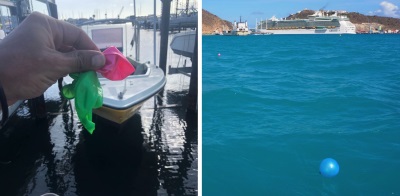 PHILIPSBURG:--- The Sint Maarten Nature Foundation over the weekend removed numerous balloons from littering the ocean. Both on Saturday and Sunday out on patrol the Foundation collected balloons drifting in the sea. Previously the Foundation had urged various organizations, including the SCDF who organized two balloon-related activities over the weekend, to find sustainable alternatives to using balloons during the two events. The Foundation had also requested the in October SCDF to limit the amount of single-use plastics at the Festival Village this year but never received a response.
PHILIPSBURG:--- The Sint Maarten Nature Foundation over the weekend removed numerous balloons from littering the ocean. Both on Saturday and Sunday out on patrol the Foundation collected balloons drifting in the sea. Previously the Foundation had urged various organizations, including the SCDF who organized two balloon-related activities over the weekend, to find sustainable alternatives to using balloons during the two events. The Foundation had also requested the in October SCDF to limit the amount of single-use plastics at the Festival Village this year but never received a response.
During last year’s Carnival, the Foundation recorded a significant increase in plastic litter and debris. “While we, of course, are not certain if these balloons originated during the two balloon-related events over the weekend we are still urging the SCDF to not only make the celebration for 50 years of carnival fun and exciting, but also sustainable and with minimal impact to our environment,” commented Nature Foundation Manager Tadzio Bervoets.
“Balloons may look nice, but they have a number of environmental concerns associated with them. What goes up must come down. Balloons are hazards when they enter the environment. All released balloons, whether they are released intentionally or not, return to Earth as ugly litter – including those marketed as “biodegradable latex”.
Balloons kill countless animals and are especially harmful to endangered sea turtle and bird species. Balloons return to the land and sea where they can be mistaken for food and eaten by animals. Sea turtles, dolphins, whales, fish and birds have been reported with balloons in their stomachs and ribbons and strings leading to entanglement and death.
There are two types of balloons in general use – latex and Mylar. Although latex balloons are considered bio-degradable, this will take anywhere from 6 months to 4 years to decompose and they can wreak a lot of havoc before they do. In one experiment researchers observed that balloons floating in seawater deteriorated much slower, and even after 12 months, still retained their elasticity. “It is very unfortunate that again we had to clean-up dangerous, plastic material after we pleaded for alternatives to be used. The same occurred after the Heineken Regatta after water-balloons were used during one of the events,” continued Bervoets.
“Many people, including the staff at the Nature Foundation, look forward to celebrating fifty years of carnival. But that celebration should not come at a cost to our natural environment and the various animals which will be killed by balloons and other single-use plastics. Therefore we are urging the SCDF to do the right thing and move away from single-use plastics. We are also urging Government and Parliament to fast-track the proposed ban on single-use plastic items,” concluded Bervoets












